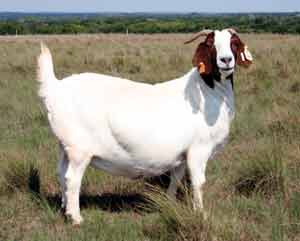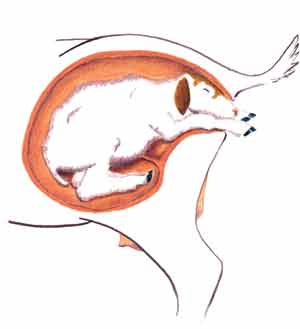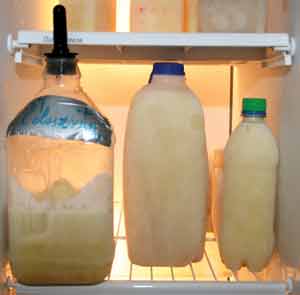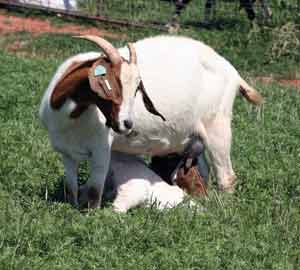Goats have different health needs according to their stage of production. Providing for these health needs will increase your chances of having a healthy, productive herd.
Pre-breeding
Breeding does
Thirty to sixty days before the breeding season does should be examined for their udder and teat conformation, dentition (teeth), musculo-skeletal problems, and feet and body condition. Culling decisions should be made. Some common conditions seen in does include lameness, chronic mastitis, bad teats, and poor body condition due to a chronic disease, parasitism, old age, or other cause. Doelings should be at least 65 to 70% of their mature weight before their first breeding.

Bad teats.
Prebreeding vaccination for Chlamydia should always be given. Leptospirosis and Campylobacter are less common causes of reproductive failure and abortion and vaccinations may be done, if the disease is present. Monitor fecal egg counts and deworm if needed. Does can be supplemented (flushed) with grain 2 to 4 weeks before breeding this will improve their fecundity (number of kids born per doe) Abrupt fence line exposure to bucks in the late transition period in the fall when does can begin to come into heat can help bring about cycling.
Breeding bucks
Bucks are too often neglected and omitted from herd health management practices. Some of the common conditions seen in bucks are urinary calculi (stones), lameness, urine scalding around the prepuce, and front leg injury due to a dominant buck in the pen. In the case of urinary scald, wash the affected area. Application of petroleum jelly can help protect the affected areas. Maintain a 2:1 ratio of dietary calcium to phosphorous and provide a high level of salt (up to 4%) and 1 to 2% ammonium chloride in the diet to prevent urinary calculi. Bucks should be vaccinated at the same time as the does and for the same diseases. Body condition and breeding soundness should be evaluated at least 4 weeks before the breeding season and adjustments made to prevent bucks from becoming overly thin or obese. As breeding season approaches, extremely aggressive and dominant bucks may need to be penned separated to prevent injury. Monitor fecal egg counts in bucks or FAMACHA score and deworm as needed.

Buck ready for breeding season.
Breeding Season
Watch does and bucks carefully during the breeding season. This is a particularly strenuous time for bucks. Lame or sick bucks will not be able to breed adequate numbers of does. Fertility is drastically decreased by hot weather. Do everything you can to cool the buck off. This may include shade and fans during the day in very hot climates.
Gestation
Pre-parturition
A kid health and management program should actually begin prior to parturition with attention to the nutritional needs of the gestating doe in late lactation and during the dry period. An adequate diet for dry does is essential to produce healthy kids. Pregnant does should be fed to have a good body condition (score of 3.0 to 3.5 just prior to kidding). Does should be scored in early pregnancy and again six weeks prior to kidding. Remember that most fetal growth occurs in the last one-third of gestation and feed quantity and quality may need to be increased during this time. Clean, cool water and free choice trace-mineralized salt should be available.

Healthy pregnant doe.
Booster vaccinations for Clostridium perfringens C and D and tetanus toxoid should be given not less than 3 weeks prior to kidding. Vitamin E/selenium injections may be given during the dry period to prevent white muscle disease in kids, especially in areas where soils are selenium deficient and supplementation is inadequate. However, a nutrition program designed to provide adequate dietary selenium is preferable to providing injections. Provide other vaccinations or boosters for diseases causing abortion. Monitor fecal egg counts or FAMACHA score and deworm as needed.
Parturition (kidding)
While most meat goat does kid on pasture, there may be times when animals are brought indoors for kidding. The doe should kid in a clean environment; either a well-drained clean pasture or a stall bedded with straw or other absorbent material. The kid prior to birth has been existing in a germ-free environment and parturition represents exposure to common disease organisms to which the mature animal has developed resistance. The kidding stall or pasture should be located near a well-traveled area so that the doe can be frequently observed for kidding difficulties. Few adult does require assistance at the time of kidding though problems are always a possibility. First-freshening does should be closely watched, especially if bred to bucks known to sire large kids.
Signs of impending kidding include udder engorgemet, swelling of the vulva, restlessness, and mucous discharge. The ligaments in the pelvic area will relax and the udder secretion’s will change from clear honey-like to thick white milk (colostrum). The doe may also lose appetite. There are three stages of parturition. Stage 1 consists of uterine contraction and cervical dilation. This stage may last from three to six hours or more. The water bag ruptures at the end of this stage. Abdominal contractions will occur in Stage 2 and the fetus should be born within one hour. If the doe is having to provide undue straining or birth is delayed then examination and assistance may be needed; particularly if the doe is straining hard for 15 minutes or more. A veterinarian may need to be called. Stage 3 consists of expulsion of the placenta and usually occurs within a few hours after the last fetus is born.
Problems in parturition
Most does will kid with little to no assistance required; however, problems can occur. Many of these problems revolve around either incorrect presentation of the fetus or a kid that is to large for the mother’s pelvis. In a normal birth presentation the forefeet will enter the birth canal first, the hooves will be pointed downwards, and the head will be between the legs. Another presentation that is sometimes seen that usually causes little problem is when the rear legs enter the birth canal first. In this case, the kid’s hooves will be pointed upwards. Abnormal presentations include the rump first (breech) or any of the legs or the head bent backwards. In these cases, assistance is required.

Normal presentation

Leg-back presentation

Head-back presentation
When assisting birth, it is important to clean the area around the vulva with disinfectant soap and warm water and to have clean hands. Wear gloves. There are certain diseases that can be transmitted to humans during this time period. Pregnant women should not assist with the kidding process. Lubricate the hand prior to entering the vagina. Feel and identify the parts of the kid. Try to ensure that all body parts felt belong to the same kid and not to two separate bodies. If you feel only one leg or no legs at all, reach further and try to determine the exact position of the fetus. Arrange the legs and/or head gently in a proper position for birth. The fetus may have to be pushed forward towards the doe’s head until a leg can be grasped and repositioned. Once the limbs are in a proper position, the kid should be gently pulled out and downwards using only your hands. Clear the mouth and nasal passages of the kid with straw or a towel and ensure it is breathing. Rubbing the body with a piece of cloth can sometimes stimulate breathing. Never pull on any presentation other than a normal presentation of two front legs and a head or a presentation of two hind legs and a tail. Pulling on any other arrangement of limbs and body parts will only make the problem worse.
If the anticipated kidding problems appear severe, call for a veterinarian immediately.
Kid management at birth
At birth two management practices are critical to the future health and survival of the newborn kid. The navel cord should be dipped in a solution of tincture of iodine (7% iodine solution) to prevent entry of disease-causing organisms through the navel cord and directly into the body of the kid. Make sure the entire cord is immersed in the iodine solution. If necessary, a long navel cord can be cut to 3 or 4 inches in length. Dipping the cord in iodine not only prevents entry of organisms but promotes rapid drying and the eventual breaking away of the cord from the navel.
Another critical practice is the feeding of colostrum as soon after birth as possible. The colostrum, or first milk, contains antibodies, which the doe does not pass to the fetal kid in the womb. Consumption of colostrum must occur as early as possible, ideally within 2-4 hours of birth. At 24 hours after birth there is a rapid reduction in the permeability of the intestinal wall to colostral antibodies. If a newborn kid does not or cannot nurse, the colostrum should be bottle-fed or the kid should be tube fed to insure adequate consumption. Excess colostrum can be frozen for use in orphan or bonus kids. Recent research indicates that disease organisms, especially caprine arthritis encephalities (CAE), may pass from doe to kid through milk and transmission might be avoided through the use of extra colostrum frozen from does tested and shown to be CAE-free or by feeding pasteurized colostrum. CAE is not considered to be a problem on most meat goat farms.
Kids should receive colostrum equal to 10% of their body weight during the first 24 hours of life. For example a six pound kid (96 ounces) should receive 10 ounces (roughly 300 ml) of colostrum within 24 hours of birth. This should be divided into at least 3 feedings. If fresh or frozen goat colostrum is not available, a commercial goat, sheep or cow colostrum replacement could be used. Fresh cow colostrum may also be used if necessary.

Colostrum ready to use.
Under certain conditions newborn kids may benefit from injections of vitamins A and D approximately four days after birth. An iron dextran injection can be given but care is needed as iron is potentially toxic. A vitamin E/selenium injection may be beneficial in areas of selenium-deficient soils. These injections should be planned with your veterinarian as part of your herd health calendar. In general injection of vitamins and minerals is not necessary. If supplementation is necessary it is done more safely by dietary supplements. Realize that the fat soluble vitamins and all minerals are toxic if given in excess.
Kids should be checked carefully at birth for any physical deformities or abnormalities. Pneumonia is a major killer of young kids. A clean, dry, draft-free environment is an excellent preventative measure.
Artificial raising of kids
Milk is the principal component of the diet of the pre-weaning kid. Most meat goat kids will nurse their dam until weaning. However, for orphaned kids or for kids of does that have lactation problems it may be necessary to use a milk replacer. Goat milk replacers are commercially available. If necessary, a lamb milk replacer may be used as a substitute for goat milk. Typical lamb milk replacers contain 22 to 24 % protein and 28 to 30% fat (on a dry matter basis). If no other milk replacer is available whole cows milk or calf milk replacers can be used. Maintaining milk replacer quality after mixing is particularly important when kids are fed ad libitum (all they can consume).
Milk can be fed by using bottles, pails, or self-feeder units. The method chosen will depend upon such factors as the size of the herd and available labor, as well as personnel preference. With any system, the health of the kid, sanitation, and available labor are the major factors to consider.
Under natural suckling, kids consume small amounts of milk at very frequent intervals. Ideally, artificial rearing should mimic natural suckling but the constraint of available labor precludes frequent feeding. Nevertheless, kids should be fed 4 to 5 times daily for the first and second week and 2 to 3 times daily thereafter. Bottle feeding is more labor intensive but kids receive more individual attention and are easier to handle post-weaning than kids that are allowed to suckle does. Pail or pan feeding may reduce labor somewhat but bodyweight loss and need for extra “training sessions” at the beginning must be expected.
For larger herds, self-feeder units such as a “lamb bar” may successfully reduce labor. The key to use of the system is the maintenance of a low temperature of the milk (40°F) that will limit intake by the kid at any one time. Small, frequent feedings increase digestibility and decrease digestive disturbances. Rapid consumption of large quantities of milk may lead to fatal bloat due to entry of milk into the reticulo-rumen. Rapid passage of milk through the abomasum and small intestines can result in diarrhea or nutritional scours.
The biggest problem with kids bottle fed lamb milk replacer occurs with the feeding schedule. Frequently kids become “pets” and there is a tendency to feed them as much milk as they will consume each feeding. Unfortunately, this may result in bloat and sudden death due to enterotoxemia or diarrhea. A restricted feeding schedule and amount is necessary.
|
Feeding Schedule and Amount for Bottle Fed Kids |
||
|---|---|---|
| Age | Amount of Fluid | Feeding Schedule |
| 1 to 3 days | 4 ounces | 5 times a day |
| 3 days to 2 weeks | 8 to 12 ounces | 4 times a day |
| 2 weeks to 3 months | 16 ounces | 3 times a day |
| 3 months to 4 months | 16 ounces | 2 times a day |
Dam raised kids
Most meat goat kids will be raised with their dams on pasture. While this removes the need for feeding milk replacer, these kids should not be forgotten in terms of nutritional and health needs. Producers must remember that since these kids are raised in the same environment as their dams, they are also exposed to the same health, disease, management, and grazing conditions. If internal parasites are a problem in the dams, expect the same in the kids and take management steps to reduce exposure to internal parasites through pasture rotation or other means. Crowding should be avoided and, if housed at any time, clean bedding and adequate ventilation are a must. Kids are naturally curious and will begin nibbling on items in their surroundings early in life. If there are toxic substances or plants, plastic, or other harmful materials lying about chances are some kids will eat them. If pasture is of very poor quality, kids beginning to nibble on grass or hay will not receive much nutritional benefit. This can slow down early growth.

Doe raising twins.
Early access to a creep feed or creep pasture containing lush, nutritious forage will benefit kids becoming accustomed to solid feed, the development of their gastrointestinal tract, and in their early growth. Entry into the area containing creep feed or pasture should be restricted to kids by fencing or gates that prevent the entry of adult animals.
Weaning

Healthy Kids
In raising goat kids, increases in size and weight are not the only measure of success. A well-formed skeleton and proper development of internal organs are often neglected when the emphasis is on rapid gains. Dry feed consumption is important in developing body capacity. By increasing body capacity, feed intake and digestion increase.
In bottle fed kids over two weeks of age, limiting daily milk consumption to about 48 ounces will encourage daily consumption of dry feed. No later than three to four weeks of age a goat/lamb creep feed, other suitable creep feed, or even a calf starter should be offered. As the hay and grain consumption increases, gradually reduce the milk being fed. When the kid is eating ¼ pound of grain per day plus some hay and is drinking water from a bucket, it is time for weaning. Research has shown that at two months of age a weaned kid has a reticulo-ruminal capacity 5 times as large as suckling kids of the same age.
Kids on pasture should be consuming forages such as pasture grass or hay by two weeks of age and grain within four. Careful attention needs be given to formulation of a concentrate supplement for the pre-weaning kid. Palatability is of primary concern. Molasses at the rate of 10% of the total dry matter, corn (preferably chopped or rolled) and whole or rolled oats make up the energy “core” of a good pre-weaning diet. Balance the crude protein needs by adding cottonseed or soybean meal or another high protein source. Though few studies with kids have been done, crude protein contents of the pre-weaning ration should be within the range of 14-18%. Ground alfalfa may be added at 5% or less to provide additional stimulation for reticuloruminal development.
Several factors need to be considered when making the decision as to weaning. The most important consideration is whether or not the average daily consumption of concentrate and forage is adequate for growth and development to continue in the absence of milk. Fixed weaning ages are less desirable than weight goals such as 2.0 to 2.5 times birth weight.
Next
Module Home
Certification Table of Contents
Browsing Table of Contents
